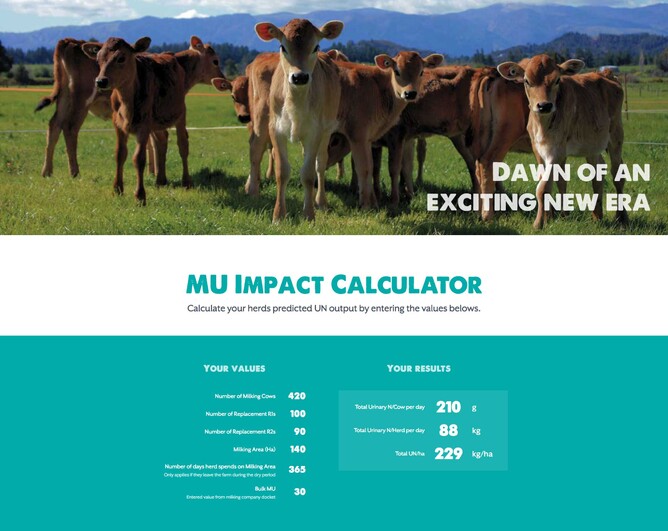CRV Ambreed has designed an assessment tool for its clients to calculate how much nitrogen their cows are excreting in urine.
It’s an online assessment tool into which the farmer inputs their own data, including the Milk Urea concentration (MU) value on their daily bulk milk reports, to calculate the amount of nitrogen their herd is excreting in urine. Knowing the numbers means they can take steps to address it if they need to.
The herd-improvement company made national headlines in 2017 when it announced a ground-breaking use of genetics. CRV Ambreed has shown it’s possible to breed cows that genetically have lower Milk Urea Nitrogen concentration (MUN). These cows are then expected to excrete less nitrogen as urine and consequently less nitrogen will be leached into groundwater. The company says a reduction of 20% in leaching within 20 years is possible by using genetics to breed cows with lower levels of MUN.
CRV Ambreed Managing Director Angus Haslett says dairy farmers understand the importance of water quality and are taking steps to safeguard it for future generations. Farmers are already playing their part and this is a further tool to help with that, he says.
“We believe there’s useful information in the daily bulk milk reports most farmers are getting and that this information can be used to calculate how much nitrogen herds are excreting,” Haslett says. “Minister David Parker wants to introduce nutrient loss limits and we believe we have a valuable tool that could help New Zealand farmers understand their situation regarding nitrogen output.”
The web-based tool, referred to as the MU Impact Calculator, has been in the pipeline since earlier this year and will be demonstrated on the CRV Ambreed stand at this year’s national Fieldays.
On farms, CRV Ambreed field consultants will work alongside clients to help them assess their herd’s nitrogen output. The farmers input data such as land area, stock numbers and the information from their bulk milk reports and will be able to test the impact of potential changes to their current system.
In addition, the MU Impact Calculator overlays a genetics aspect to the results, to demonstrate how using CRV Ambreed’s LowN Sires team of bulls could reduce a herd’s nitrogen output over time.
“We understand that genetics can potentially play a significant part and we also know that understanding specific situations is important to being able to take action,” Haslett says.
The firm is committed to helping New Zealand cement its position as a sustainable dairying country and is looking to improve on predictive modelling. “If we are serious about our environment, we need to more accurately understand what’s being put onto the land, and the CRV Ambreed assessment tool can go a long way towards that.”
CRV Ambreed’s head of R&D Phil Beatson says farmers are making great gains in helping the environment. Farmers who understand a herd’s MU levels (and therefore its nitrogen output) could make even larger gains, he says.
MU is an indicator of how much dietary nitrogen (consumed by the cow as plant protein) is not being used for production and is excreted in urine. Nitrogen excreted in the urine is particularly important because the high concentration of nitrogen in urine coupled with the small area of the urine patch means the plants and soil cannot cope with the nitrogen.
Beatson says about 45% of dietary nitrogen is excreted in urine. This amounts to each cow excreting about 75kg of nitrogen a year in urine and this urinary nitrogen is the primary source of nitrogen leaching. Across all New Zealand about 20% of urinary nitrogen is leached into groundwater. More information is available here.
CRV Ambreed can be found at the national Fieldays across a double site of E64 and F63, close to the main pavilion. This year’s Fieldays run 13-16 June at Mystery Creek near Hamilton.
For more about LowN Sires visit: crv4all.co.nz/LowNsires/

